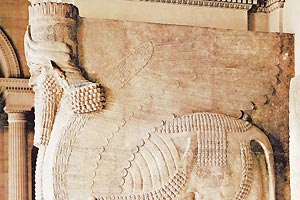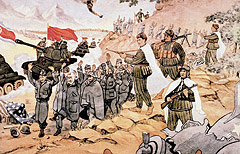The Akkadians
Towards the mid-third millennium B.C., the Semitic tribes that settled in Mesopotamia became sedentary and imposed their dominance. And although they absorbed the Sumerian culture and knowledge, Sumerians died out. The Akkadians reached their greatest splendor during the reign of Sargon I (late 24th century B.C.). This king created the first Semite Empire by uniting the Sumerian city-states and conquering territories as far as the Mediterranean Sea to the west and the Zagros Mountains (in Iran) to the east.
The capital of the empire was the city of Akkad, which lent its name to the inhabitants and the region.
The Akkadian power waned as a result of the Guti and Amorite invasions from the mountains north of the empire, but later the Sumerian culture resurged under the third dynasty in the city of Ur.
The Babylonians
Following a new wave of Semitic invasions around 2,000 B.C., Mesopotamia was once more divided into city-states.
One of their kings founded the city of Babylonia, which then became the center of the empire. Just like the city of Akkad before it, the name of Babylon came to designate the entire region.
Later on, king Hammurabi (1,792-1,750 B.C.) created a great kingdom and unified its political and religious organization. Under his rule, Babylonia became the leading trading center of western Asia.
The king also created the first code of law, known as the «Hammurabi Code«.
Towards 1,600 B.C., the Hittites, a people from Asia Minor, plundered and destroyed the city of Babylon. The region was subsequently occupied by the Kassites. Their dynasty governed Babylonia or Karduniash, as they called it, from approximately 1,531 to 1,155 B.C, the year when they were overthrown by the Elamites from southwest Iran.
The Assyrian Empire
Also of Semitic origin, the Assyrians began settling the northern portion of Babylonia around 1,250 B.C. Their main cities were Nineveh and Assur.
The Assyrians were warriors who proved their power by destroying the cities they conquered, killing, capturing or exiling their inhabitants.
The Assyrian Empire pinnacled near 700 B.C., at a time when it extended from Armenia and Iran to the east to Egypt to the west, and from Asia Minor to the north to the Persian Gulf to the south.
The last great Assyrian emperor, Assurbanipal, ordered the construction of magnificent temples and palaces and fostered the flourishing of art and the letters. In Niniveh he created a library to keep clay tablets engraved with cuneiform writings. Once unearthed by archeologists, these tablets became valuable tools to find out more about the Sumerian, Akkadian, Babylonian and
The Assyrian violence and repression, together with the high taxes they demanded, caused the oppressed peoples to uprise.
The king of the city of Babylon joined forces with the Indo-European Medes who entered Assyria from Iran. The Assyrian capital, Niniveh, was finally defeated in 612 B.C. and its luxurious palaces and temples burnt to ashes. Its last king, Sardanapalus, reportedly jumped into the flames.
The Neo-Babylonians
Nabopolassar, the leader of the Semite tribe called Chaldeans, refounded the city of Babylon in the late 8th century B.C. The region was called Chaldea, the name used to refer to it in Biblical texts.
Its most important ruler was king Nebuchadnezzar II the Great (605-562 B.C.), who extended his dominion to the west as far as Syria and the Mediterranean coast. He faced Egypt in battle, subdued Judea, destroyed the city of Jerusalem (587 B.C.), where he captured thousands of Israelites, and conquered part of Arabia.
Nebuchadnezzar’s legacy includes the reconstruction and beautification of Babylon. Besides its monumental double fortification (the first wall was eight meters thick while the second was seven meters) and the beautiful gates to the city, the royal palace housed the Hanging Gardens, one of the seven wonders of the ancient world. In the center of the city stood the ziggurat or tiered temple dedicated to god Marduk. Given its height (more than 90 meters) it is usually associated with the Babel tower mentioned in the Bible.
The end of Mesopotamic civilizations occurred in 539 B.C., when Babylonia fell to the Persian army of king Cyrus II the Great. The region became one of the most powerful provinces of the Achaemenid Empire.
In 331 B.C. Mesopotamia was invaded by the troops of Macedonian king and conqueror Alexander the Great who eventually subdued the Persians.








 Termina la Guerra de Corea
Termina la Guerra de Corea